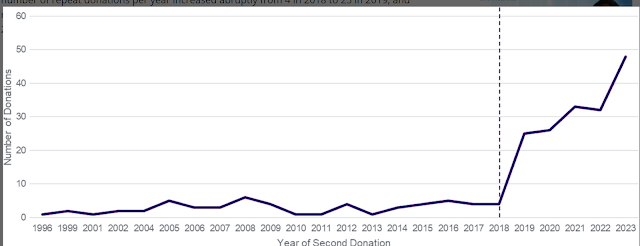And here's the press release:
LOS ANGELES--(BUSINESS WIRE)--ABUNDANT,
a documentary film that follows the unbelievable events surrounding
extreme altruists who donated kidneys to complete strangers, has set its
world premiere in Hollywood at The Directors Guild of America Theater
Complex on March 1, 2025. The event is presented by OneLegacy Inspires Hollywood
and The National Kidney Donation Organization (NKDO) as a kickoff to
National Kidney Month. OneLegacy Inspires Hollywood champions authentic
and accurate storytelling that highlight the power of organ, eye and
tissue donation and transplantation.
“ABUNDANT moves us beyond a mindset of scarcity, reminding us of our shared humanity and connection”
The film’s world premiere is an entertainment industry event to showcase
the often-miraculous stories connected to altruistic acts such as
living kidney donation. “ABUNDANT moves us beyond a mindset of
scarcity, reminding us of our shared humanity and connection,” said
Sarah E. Fahey, Chair of OneLegacy Inspires Hollywood. “Through a
powerful emotional journey of joy, grief, and hope, the film keeps
audiences engaged from start to finish—and lingers long after the
credits roll. OneLegacy Inspires Hollywood is thrilled to partner with
NKDO and Maitri River Productions to premiere this impactful story
during National Kidney Month here in Hollywood. This is the movie Los
Angeles, and the world, needs right now,” Fahey added.
The choice of Los Angeles for ABUNDANT’s
world premiere was in part inspired by the widespread acts of
generosity, kindness and abundance displayed by the Los Angeles
community during the recent wildfires. “One thing became obvious to me
about abundance and altruism when I was making ABUNDANT,” said
Director Donald Griswold. “Acts of abundance or generosity don’t have to
be life-saving or dramatic to impact another person’s life
meaningfully. We’re all fascinated by the non-directed kidney donors who
give a kidney to a stranger, but viewers walk away from the film
realizing that small acts and everyday kindnesses make an important
impact, too. We saw that in so many ways in LA these last few weeks. We
had to show ABUNDANT for the first time here and now.”
National Kidney Donation Organization supports ABUNDANT as part
of an effort to gain more attention for kidney donation stories. “We are
proud to have a hand in sharing this life-affirming message of hope and
goodness with the people of LA, and with all those across the country
who might be inspired by it,” said Emily Polet-Monteserro, Executive
Director, National Kidney Donation Organization. “This compelling film
uses the vehicle of kidney donation to encourage the audience to
consider what it means for them to live fully and with love toward
everyone, including strangers.”
ABUNDANT includes interviews with 2012 Nobel Prize Laureate Alvin Roth, PhD, Freakonomics Radio
host Stephen Dubner, author and researcher Abigail Marsh, PhD, and
business leader in the field of system change, Tynesia Boyea-Robinson
among other notable personalities. The film features first-hand stories
of non-directed kidney donation (where a person donates a kidney to a
complete stranger) in a never-before-seen way of telling stories.
#############
Earlier:






